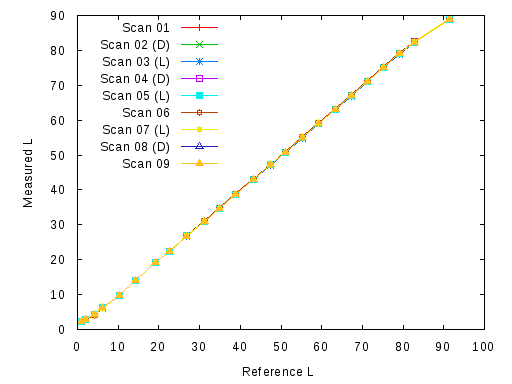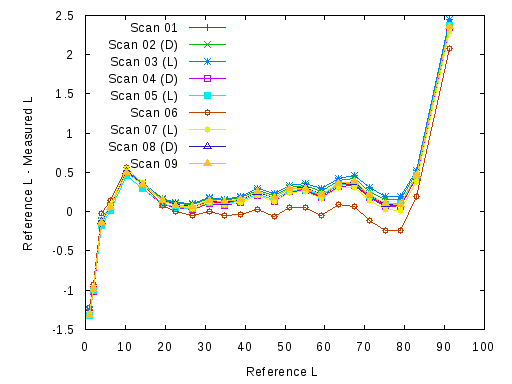Nikon Scan Issues
The Nikon Scan documentation omits some important details, and Nikon USA technical support seems unable to answer highly technical questions. This lack of reliable information makes it difficult to determine the best choice of software settings to allow colour management to be applied externally to Nikon Scan. These notes describe a set of experiments to determine the veracity of some of the relevant arguments found on internet forums. All scans were made on a Coolscan 9000ED, using Nikon Scan 4.0.2 running under Windows XP.
There is no absolute default exposure
The claim is that Nikon Scan has no absolute default exposure, so that the exposure obtained when scanning without Auto Exposure depends on the most recent scan with Auto Exposure enabled:
A number of scans were made of a Wolf Faust IT8.7 target with auto-exposure off, interleaved with scans of light and dark slides with auto-exposure on. If the above claim is true, one would expect to see a significant difference in the IT8.7 scans depending on the properties of the preceding slide scanned with auto-exposure on. The exposure settings for the IT8.7 scans were compared by plotting measured against reference L (the luminosity channel of the Lab colour space) of the GSnn greyscale patches, displayed in the figure below. The reference L values were extracted from the reference data provided with the IT8.7 target, and the measured L values were obtained using Argyll CMS tools to measure RGB values for each IT8.7 scan followed by conversion to Lab using a common device profile.

In the plot above, Scan01 and Scan06 were performed at the beginning of a scanning session, without any recorded preceding scan history, and the scans labelled (D) and (L) were made following scans, with auto-exposure on, of particularly dark and particularly light slides respectively. Since the range of the plot obscures small differences, an additional comparison was made by plotting the difference between reference and measured L against reference L, displayed below.

Small differences are visible in this plot, and the deviation of Scan06 from the others is unexplained, but the balance of evidence suggests that the exposure level with auto-exposure disabled is not determined by the most recent scan with auto-exposure enabled, in Nikon Scan 4.0.2 at least.
Auto exposure is difficult to disable
The claim is that auto exposure is not necessarily disabled when the control settings imply that it is:
and:
An over-exposed slide was scanned with auto-exposure disabled, and then again with auto-exposure enabled, and a significant difference was observed in the histograms for each scan. Various combinations of auto-exposure settings, film holder ejection, and scanner power cycling were then tried to discover what is required to disable auto-exposure, as determined by observation of changes in the histogram display. The conclusion is that the above claims are at least partially correct:
- Merely deselecting the auto-exposure setting is not sufficient for it to be disabled. Restarting Nikon Scan is also insufficient, but ejecting the film holder or power cycling the scanner will activate the changes.
- It is not necessary to switch off "AE for negatives" in order to disable auto-exposure for positive film.
Image data is in sRGB when CMS is disabled
The claim is that image data is actually in the sRGB colour space rather than the device colour space when CMS is disabled:
Aside from the subjective nature of the experiment, the above argument is based on confusion between the gamut of the device and the working colour spaces: if the Wide Gamut RGB colour space has a wider gamut than the device space, then the effect described above is expected when Nikon Scan has converted scanner data into that space, and it does not imply that the device actually has the same gamut. The images (viewable in 3D when a VRML plugin is available) below show comparisons, made using Argyll CMS tools, of the gamuts of the sRGB, Coolscan 9000ED device, and Wide Gamut RGB colour spaces. Clearly the device colour space has a gamut intermediate between that of sRGB and Wide Gamut RGB. There is no convincing reason to expect that scans with CMS off (or with Scanner RGB) have a reduced gamut, and it is reasonable to assume that the sRGB tag on such scans is simply an error in the metadata written by Nikon Scan.
|
Comparison of sRGB and Coolscan 9000 device gamuts. |
Comparison of Coolscan 9000 device and Wide Gamut RGB gamuts. |
Comments, suggestions, error corrections etc. are welcome.

